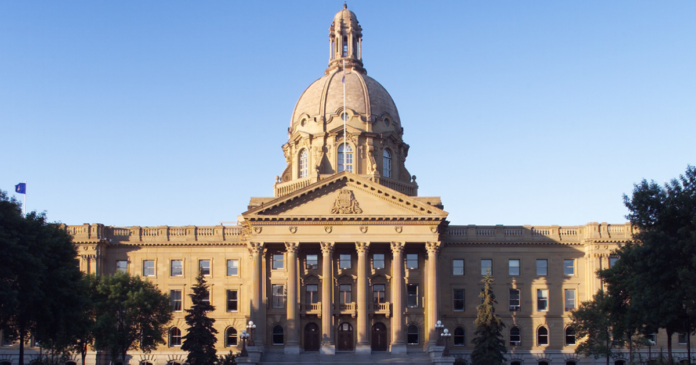The Alberta government unveiled its 2024 budget, showing that the taxpayer support debt of $78.4 billion is equal to 106.6% of total revenue.
The budget, poised to bolster the province’s status as Canada’s economic powerhouse, forecasts a $367 million surplus for the fiscal year 2024-25. The surplus is set to increase to $1.4 billion in 2025-26 and $2.6 billion in 2026-27.
Despite the technical surplus, the province is projected to borrow $19.8 billion for 2024-25, $5.4 billion for refinancing maturing debt, $2.8 billion in new funding for the capital plan and year-end cash adjustments, and $11.6 billion to repay debt maturities coming in 2025-26.
The borrowing is expected to decrease to $4.4 billion in 2025-26 and $8 billion in 2026-27.
The province justified the high amount of debt by saying that it needed to borrow in advance of its immediate cash needs. The funds raised in advance will be held in a designated debt retirement account. The cash will be invested in high-quality bonds to the maturity dates of the existing debts, ensuring the province is positioned to repay bonds as they come due.
Alberta’s revenue of $73.5 billion is offset by total expenses of $71.2 billion and an additional $2 billion for contingency and disaster expenses. While the revenues have decreased since last year, the expenses increased, leading to a lower surplus compared to the $5.2 billion in 2023-24.
The net debt to GDP ratio decreased from 9.3% in 2023-24 to 9.1% in 2024-25. It is expected to drop further from 8.5% and 7.7% in the subsequent years.
Minister of Finance Nate Horner underscored the budget’s balanced approach.
“Alberta is growing. Budget 2024 is a plan that manages the pressures faced by a growing province today while securing the future for generations who follow. I’m proud of the choices we made in this budget that support Albertans’ top priorities and prepare our province to meet the challenges that lie ahead. Budget 2024 invests today and saves for tomorrow so we can continue to be the nation’s economic engine,” he said.
Alberta has pledged to use at least half of any surplus funds to reduce the province’s taxpayer-supported debt, which is projected to decrease by $3.2 billion in the 2023-24 fiscal year.
Alberta will invest $2 billion more into the Heritage Fund, with earnings retained in the fund at $1.38 billion. The market value of the Heritage Fund will be $25 billion.
Health care emerges as a top priority, with a record $26.2 billion investment to enhance services, including mental health support and the modernization of the primary health care system.
The funding consists of $475 million for primary health care and $4.4 billion for acute care. Additionally, $126 million over three years is allocated towards a rural physician expansion, and more than $6.6 billion is dedicated to physician compensation and business support. Continuing care will receive $1 billion over three years.
Mental health and addiction services are set to receive $1.13 billion in 2024-25, with $3.6 billion earmarked over three years for health capital projects.
Education also receives a substantial boost, with $9.3 billion allocated to support burgeoning enrolment numbers, hire additional staff, and cater to specialized student needs. $1.2 billion is designated for enrollment growth over three years. Vulnerable students will be supported with $1.5 billion in funding. $1.9 billion will go towards new school projects over three years.
By 2026, parents will pay an average of $10 per day for child care. Plans to help reduce costs for families are to provide grants to not-for-profit and private child care operators to lower fees and to expand eligibility for child care subsidies, providing cost saving to families earning up to $180,000 per year.
The budget also addresses public safety and community well-being, earmarking $1.2 billion for emergency services and initiatives to combat crime, alongside significant investments in wildfire management and disaster preparedness.
In terms of economic outlook, Alberta anticipates a 2.9% growth in real GDP for 2024, backed by strong population growth and strategic investments in key sectors. However, Alberta’s real GDP per capita is decreasing and is expected to rebound in 2025. The rebound will still remain below 2019 levels as economic growth lags behind Alberta’s population growth.
The province’s population is forecast to grow by 3.7%, 175,000 people, below the 4.1% increase of last year. Non-permanent residents are forecast to be driven by the arrival of approximately 30,000 Ukrainians under the Canada-Ukraine Authorization for Emergency Travel, as well as students and work permit holders. Alberta is forecast to welcome more than 53,000 people from the rest of the country, below last year’s record of 56,000.
Low personal and corporate income taxes, low fuel tax, and no sales tax results in Albertans paying generally lower taxes than residents of other provinces.
“In 2024-25, Albertans and Alberta businesses would pay at least $19 billion more in taxes if Alberta had the same tax system as any other province,” said the Alberta government in its fiscal update.
Budget 2024 also announced the implementation of the Alberta is Calling Attraction Bonus, a one-time payment of a $5,000 refundable tax credit to individuals working in eligible occupations who move to Alberta after the program start date in April 2024. This program will provide a total of $10 million in benefits to workers.
The Alberta government plans to introduce a new tax cut over the next two years. In 2026, a 9% bracket will be introduced for income up to $60,000. The rate will be reduced to 8% in 2027. Taxpayer savings are expected to be $760 annually once the tax cut is fully implemented, with total annual savings of $1.4 billion.















